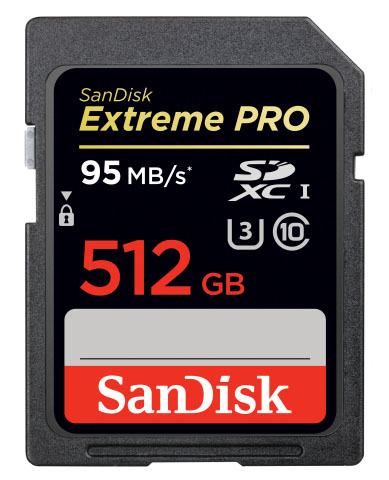SanDisk Launches Extreme PRO SD Cards: Up to 512GB
by Kristian Vättö on September 11, 2014 3:38 PM EST- Posted in
- Storage
- SanDisk
- SD cards
- Extreme Pro

While we don't usually cover SD cards, SanDisk's announcement of 512GB Extreme PRO SD card caught my eye today. There are currently only a couple of 256GB SD cards available and most OEMs have not been able to go above 128GB, so the Extreme PRO is the highest capacity SD card in the world, which really speaks for SanDisk's NAND and packaging expertise.
| SanDisk Extreme PRO SDXC UHS-I Memory Card Specifications | |||||||||
| Capacities | 128GB, 256GB & 512GB | ||||||||
| Read Speed | Up to 95MB/s | ||||||||
| Write Speed | Up to 90MB/s | ||||||||
| Warranty | Lifetime Limited | ||||||||
The Extreme PRO comes in SDXC format and utilizes UHS-I interface, which is good for up to 104MB/s. As you can see in the table above, the Extreme PRO comes very close to saturating the interface and it carries UHS Speed Class 3 rating, meaning that it is suitable for capturing 4K video. The largest market for the new Extreme PRO SD cards is obviously video professionals because as we transition to 4K video, the need for storage increases substantially, which in turn opens market for larger SD cards.
While SanDisk didn't release any details of the internals, it's pretty safe to assume that the 512GB Extreme PRO consists of 32 x 128Gbit (16GB) dies. The photo above is from SanDisk's 2014 Investor Day presentation where the company claimed that it has the technology for a 32-die SDXC card and with the Extreme PRO the technology has made it into the retail. Since SanDisk/Toshiba doesn't have a 256Gbit NAND die (nobody has one in mass production yet), the only way to achieve 512GB is through a 32-die stack. SanDisk hasn't specified whether the NAND is MLC or TLC, but given that it is a high-end product I'm guessing it is MLC based.
EDIT: As some of you mentioned in the comments, it seems to be two 16-die stacks instead of a single 32-die stack. SD cards definitely have the room for two die stacks and the photo also shows two 16-die stacks instead of a single 32-die stack. Either way it is impressive since nothing else comes close to the capacity SanDisk offers.
All capacities are available now and the MSRP for the 512GB model is $800, which is certainly high since 512GB SSDs retail for close to $200. However, the Extreme PRO is the only SD card that is available in such a high capacity, so I would say the premium is justified. Stacking more dies on top of each other will always have a negative impact on yield as the wires have to be longer and there are more wires to connect, so the room for errors increases and thus the manufacturing cost goes up as well.











54 Comments
View All Comments
Kristian Vättö - Friday, September 12, 2014 - link
Good point. Now that I look at the photo more carefully, it seems to be two 16-die stacks instead of one 32-die stack. I've added an update to mention this, but either way it is impressive since nobody else comes close to the density SanDisk offers.hojnikb - Friday, September 12, 2014 - link
Yeah, as far as sd card desity goes, they are really ahead. As far as chip density, samsung had 16 die stack for quite some time now (840EVO msata and 830 also had 16 die stack if i'm not mistaken).jjj - Friday, September 12, 2014 - link
4x16 64Gb makes more sense yield wise and even logistics wise (manage production,inventory) since they already have those from the 128GB microSD but less die area efficient so hard to say what would come on top cost wise.Another problem is that they might not be able to reach the rated speed with just 2 stacks but they sure can with 4.
hojnikb - Friday, September 12, 2014 - link
They are most defenetly not using 64Gbit dies. For start, there is no room for 4 packages (as it would be reqired red for 16 die stackes each 64Gbit large). So they are most defenetly doing 128Gbit, as these kind of dies are also used for SSDs and flash drives. They just need to stack more of them into a single package (other products top at 8 stacks) so its probobly gonna be exclusive for this sd card for now (unless they bring out 1TB msata).As far as speed is concerned; There is plenty of dies to make ~100MB R/W. Read are no problem (Since those are limited by controller anyway) but for writes, they probobly need around 4 decently binned 128Gbit dies to hit 100MB/s. So plenty of room here, since card itself employs 32 dies total (so really no need for 64Gbit dies).
jjj - Friday, September 12, 2014 - link
There is room for 4 stacks of any of their 3 most recent processes. The dies are 80-85mm2 for 15nm and 94mm2 and 113mm2 for the two 19nm genshojnikb - Friday, September 12, 2014 - link
Actually, there is room for 16 stacks (just like its shown in the picture).So i really dont get what you're traing to say here. It's NOT 64Gbit, you can be sure of that. It makes no sense.
hojnikb - Saturday, September 13, 2014 - link
trying*Samwise Clemens - Wednesday, September 17, 2014 - link
unless who brings out 1TB mSata? http://www.newegg.com/Product/Product.aspx?Item=N8...chris471 - Friday, September 12, 2014 - link
Hmm, at 95MB/s, if I ever fill it completely, I'd need about 2 hours to copy it to my workstation. At these capacities, we really need faster interfaces.hojnikb - Friday, September 12, 2014 - link
We already have UHS-II, which is capable of 312MB/s